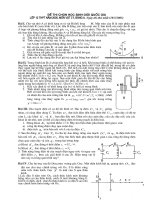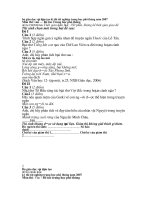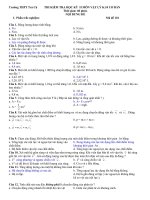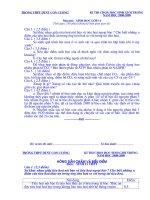Đề thi và đáp án CMO năm 2005
Bạn đang xem bản rút gọn của tài liệu. Xem và tải ngay bản đầy đủ của tài liệu tại đây (77.22 KB, 9 trang )
<span class='text_page_counter'>(1)</span><div class='page_container' data-page=1>
<b>Solutions to the 2005 CMO</b>
written March 30, 2005
1. Consider an equilateral triangle of side length <i>n</i>, which is divided into unit triangles, as
shown. Let<i>f</i>(<i>n</i>) be the number of paths from the triangle in the top row to the middle
triangle in the bottom row, such that adjacent triangles in our path share a common
edge and the path never travels up (froma lower row to a higher row) or revisits a
triangle. An example of one such path is illustrated below for <i>n</i> = 5. Determine the
value of<i>f</i>(2005).
<b>Solution</b>
We shall show that <i>f</i>(<i>n</i>) = (<i>n−</i>1)!.
Label the horizontal line segments in the triangle <i>l</i><sub>1</sub>, <i>l</i><sub>2</sub>, . . . as in the diagram below.
Since the path goes fromthe top triangle to a triangle in the bottomrow and never
travels up, the path must cross each of <i>l</i><sub>1</sub><i>, l</i><sub>2</sub><i>, . . . , l<sub>n</sub><sub>−</sub></i><sub>1</sub> exactly once. The diagonal lines
in the triangle divide<i>l<sub>k</sub></i> into<i>k</i> unit line segments and the path must cross exactly one
of these <i>k</i> segments for each <i>k</i>. (In the diagrambelow, these line segments have been
highlighted.) The path is completely determined by the set of <i>n</i> <i>−</i>1 line segments
which are crossed. So as the path moves from the <i>k</i>th row to the (<i>k</i> + 1)st row,
there are <i>k</i> possible line segments where the path could cross <i>l<sub>k</sub></i>. Since there are
1<i>·</i>2<i>·</i>3<i>· · ·</i>(<i>n−</i>1) = (<i>n−</i>1)! ways that the path could cross the <i>n−</i>1 horizontal lines,
and each one corresponds to a unique path, we get <i>f</i>(<i>n</i>) = (<i>n−</i>1)!.
Therefore<i>f</i>(2005) = (2004)!.
<i>l</i>1
<i>l</i>2
<i>l</i>3
</div>
<span class='text_page_counter'>(2)</span><div class='page_container' data-page=2>
<i>a, b, c</i> <i>i.e.</i> <i>a</i> <i>b</i> <i>c</i>
a) Prove that (<i>c/a</i>+<i>c/b</i>)2 <i>></i>8.
b) Prove that there does not exist any integer<i>n</i>for which we can find a Pythagorean
triple (<i>a, b, c</i>) satisfying (<i>c/a</i>+<i>c/b</i>)2 =<i>n</i>.
a) <b>Solution 1</b>
Let (<i>a, b, c</i>) be a Pythagorean triple. View <i>a, b</i> as lengths of the legs of a right
angled triangle with hypotenuse of length<i>c</i>; let<i>θ</i> be the angle determined by the
sides with lengths<i>a</i> and <i>c</i>. Then
<i><sub>c</sub></i>
<i>a</i> +
<i>c</i>
<i>b</i>
<sub>2</sub>
=
1
cos<i>θ</i> +
1
sin<i>θ</i>
<sub>2</sub>
= sin
2<i><sub>θ</sub></i><sub>+ cos</sub>2<i><sub>θ</sub></i><sub>+ 2 sin</sub><i><sub>θ</sub></i><sub>cos</sub><i><sub>θ</sub></i>
(sin<i>θ</i>cos<i>θ</i>)2
= 4
1 + sin 2<i>θ</i>
sin22<i>θ</i>
= 4
sin22<i>θ</i> +
4
sin 2<i>θ</i>
Note that because 0 <i>< θ <</i> 90<i>◦</i>, we have 0 <i><</i> sin 2<i>θ</i> <i>≤</i> 1, with equality only if
<i>θ</i> = 45<i>◦</i>. But then <i>a</i> =<i>b</i> and we obtain <i>√</i>2 = <i>c/a</i>, contradicting <i>a, c</i> both being
integers. Thus, 0<i><</i>sin 2<i>θ <</i> 1 which gives (<i>c/a</i>+<i>c/b</i>)2 <i>></i>8.
<b>Solution 2</b>
Defining <i>θ</i> as in Solution 1, we have <i>c/a</i>+<i>c/b</i> = sec<i>θ</i> + csc<i>θ</i>. By the AM-GM
inequality, we have (sec<i>θ</i>+ csc<i>θ</i>)<i>/</i>2<i>≥√</i>sec<i>θ</i>csc<i>θ</i>. So
<i>c/a</i>+<i>c/b≥</i> <i>√</i> 2
sin<i>θ</i>cos<i>θ</i> =
2<i>√</i>2
<i>√</i>
sin 2<i>θ</i> <i>≥</i>2
<i>√</i>
2<i>.</i>
Since<i>a, b, c</i> are integers, we have <i>c/a</i>+<i>c/b ></i>2<i>√</i>2 which gives (<i>c/a</i>+<i>c/b</i>)2 <i>></i>8.
<b>Solution 3</b>
By simplifying and using the AM-GM inequality,
<i><sub>c</sub></i>
<i>a</i> +
<i>c</i>
<i>b</i>
<sub>2</sub>
=<i>c</i>2
<i>a</i>+<i>b</i>
<i>ab</i>
2
= (<i>a</i>
2<sub>+</sub><i><sub>b</sub></i>2<sub>)(</sub><i><sub>a</sub></i><sub>+</sub><i><sub>b</sub></i><sub>)</sub>2
<i>a</i>2<i><sub>b</sub></i>2 <i>≥</i>
2<i>√a</i>2<i>b</i>2(2<i>√ab</i>)2
<i>a</i>2<i><sub>b</sub></i>2 = 8<i>,</i>
with equality only if<i>a</i>=<i>b</i>. By using the same argument as in Solution 1,<i>a</i>cannot
equal <i>b</i> and the inequality is strict.
<b>Solution 4</b>
<i><sub>c</sub></i>
<i>a</i> +
<i>c</i>
<i>b</i>
<sub>2</sub>
= <i>c</i>
2
<i>a</i>2 +
<i>c</i>2
<i>b</i>2 +
2<i>c</i>2
<i>ab</i> = 1 +
<i>b</i>2
<i>a</i>2 +
<i>a</i>2
<i>b</i>2 + 1 +
2(<i>a</i>2+<i>b</i>2)
<i>ab</i>
= 2 +
<i>a</i>
<i>b</i> <i>−</i>
<i>b</i>
<i>a</i>
<sub>2</sub>
+ 2 + 2
<i>ab</i>
(<i>a−b</i>)2+ 2<i>ab</i>
= 4 +
<i>a</i>
<i>b</i> <i>−</i>
<i>b</i>
<i>a</i>
<sub>2</sub>
+ 2(<i>a−b</i>)
2
<i>ab</i> + 4<i>≥</i>8<i>,</i>
</div>
<span class='text_page_counter'>(3)</span><div class='page_container' data-page=3>
b) <b>Solution 1</b>
Since <i>c/a</i>+<i>c/b</i> is rational, (<i>c/a</i>+<i>c/b</i>)2 can only be an integer if <i>c/a</i>+<i>c/b</i> is an
integer. Suppose <i>c/a</i>+<i>c/b</i> = <i>m</i>. We may assume that gcd(<i>a, b</i>) = 1. (If not,
divide the common factor from (<i>a, b, c</i>), leaving <i>m</i> unchanged.)
Since<i>c</i>(<i>a</i>+<i>b</i>) =<i>mab</i>and gcd(<i>a, a</i>+<i>b</i>) = 1,<i>a</i>must divide<i>c</i>, say<i>c</i>=<i>ak</i>. This gives
<i>a</i>2<sub>+</sub><i><sub>b</sub></i>2 <sub>=</sub><i><sub>a</sub></i>2<i><sub>k</sub></i>2 <sub>which implies</sub> <i><sub>b</sub></i>2 <sub>= (</sub><i><sub>k</sub></i>2<i><sub>−</sub></i><sub>1)</sub><i><sub>a</sub></i>2<sub>. But then</sub> <i><sub>a</sub></i> <sub>divides</sub> <i><sub>b</sub></i> <sub>contradicting</sub>
the fact that gcd(<i>a, b</i>) = 1. Therefore (<i>c/a</i>+<i>c/b</i>)2 is not equal to any integer <i>n</i>.
<b>Solution 2</b>
We begin as in Solution 1, supposing that <i>c/a</i>+<i>c/b</i> = <i>m</i> with gcd(<i>a, b</i>) = 1.
Hence <i>a</i> and <i>b</i> are not both even. It is also the case that <i>a</i> and <i>b</i> are not both
odd, for then <i>c</i>2 = <i>a</i>2 +<i>b</i>2 <i>≡</i> 2 (mod 4), and perfect squares are congruent to
either 0 or 1 modulo 4. So one of <i>a, b</i> is odd and the other is even. Therefore
<i>c</i>must be odd.
</div>
<span class='text_page_counter'>(4)</span><div class='page_container' data-page=4>
a) Show that there are three distinct points <i>a, b, c</i> <i>∈</i> <i>S</i> and three distinct points
<i>A, B, C</i> on the circle such that<i>a</i> is (strictly) closer to <i>A</i> than any other point in
<i>S</i>, <i>b</i> is closer to <i>B</i> than any other point in <i>S</i> and <i>c</i> is closer to <i>C</i> than any other
point in <i>S</i>.
b) Show that for no value of <i>n</i> can four such points in <i>S</i> (and corresponding points
on the circle) be guaranteed.
<b>Solution 1</b>
a) Let <i>H</i> be the smallest convex set of points in the plane which contains <i>S</i>.<i>†</i> Take
3 points <i>a, b, c</i> <i>∈</i> <i>S</i> which lie on the boundary of <i>H</i>. (There m ust always be at
least 3 (but not necessarily 4) such points.)
Since<i>a</i> lies on the boundary of the convex region <i>H</i>, we can construct a chord <i>L</i>
such that no two points of<i>H</i> lie on opposite sides of <i>L</i>. Of the two points where
the perpendicular to <i>L</i> at <i>a</i> meets the circle, choose one which is on a side of <i>L</i>
not containing any points of <i>H</i> and call this point <i>A</i>. Certainly <i>A</i> is closer to <i>a</i>
than to any other point on <i>L</i> or on the other side of <i>L</i>. Hence <i>A</i> is closer to <i>a</i>
than to any other point of <i>S</i>. We can find the required points <i>B</i> and <i>C</i> in an
analogous way and the proof is complete.
[Note that this argument still holds if all the points of<i>S</i> lie on a line.]
<i>H</i>
<i>a</i>
<i>b</i>
<i>c</i> <i><sub>L</sub></i>
<i>A</i>
(a)
<i>P</i>
<i>Q</i> <i>R</i>
<i>a</i> <i>b</i>
<i>c</i>
<i>r</i>
<i>r</i>
<i>√</i>
3
2 <i>r</i>
(b)
b) Let <i>P QR</i> be an equilateral triangle inscribed in the circle and let <i>a, b, c</i> be
mid-points of the three sides of <i>P QR</i>. If <i>r</i> is the radius of the circle, then every
point on the circle is within (<i>√</i>3<i>/</i>2)<i>r</i> of one of <i>a</i>,<i>b</i> or<i>c</i>. (See figure (b) above.)
Now<i>√</i>3<i>/</i>2<i><</i>9<i>/</i>10, so if<i>S</i> consists of <i>a, b, c</i> and a cluster of points within <i>r/</i>10 of
the centre of the circle, then we cannot select 4 points from<i>S</i> (and corresponding
points on the circle) having the desired property.
</div>
<span class='text_page_counter'>(5)</span><div class='page_container' data-page=5>
<b>Solution 2</b>
a) If all the points of <i>S</i> lie on a line <i>L</i>, then choose any 3 of themto be <i>a, b, c</i>. Let
<i>A</i> be a point on the circle which meets the perpendicular to<i>L</i> at<i>a</i>. Clearly<i>A</i> is
closer to<i>a</i> than to any other point on <i>L</i>, and hence closer than other other point
in<i>S</i>. We find <i>B</i> and <i>C</i> in an analogous way.
Otherwise, choose <i>a, b, c</i> from <i>S</i> so that the triangle formed by these points has
maximal area. Construct the altitude from the side<i>bc</i> to the point <i>a</i> and extend
this line until it meets the circle at<i>A</i>. We claimthat <i>A</i> is closer to<i>a</i> than to any
other point in <i>S</i>.
Suppose not. Let<i>x</i>be a point in<i>S</i> for which the distance from<i>A</i>to<i>x</i>is less than
the distance from<i>A</i> to<i>a</i>. Then the perpendicular distance from<i>x</i> to the line <i>bc</i>
must be greater than the perpendicular distance from <i>a</i> to the line <i>bc</i>. But then
the triangle formed by the points<i>x, b, c</i>has greater area than the triangle formed
by<i>a, b, c</i>, contradicting the original choice of these 3 points. Therefore<i>A</i> is closer
to<i>a</i> than to any other point in <i>S</i>.
The points<i>B</i> and <i>C</i> are found by constructing similar altitudes through <i>b</i> and <i>c</i>,
respectively.
</div>
<span class='text_page_counter'>(6)</span><div class='page_container' data-page=6>
maximum value of <i>KP/R</i>3.
<b>Solution 1</b>
Since similar triangles give the same value of <i>KP/R</i>3, we can fix <i>R</i>= 1 and maximize
<i>KP</i> over all triangles inscribed in the unit circle. Fix points<i>A</i>and<i>B</i> on the unit circle.
The locus of points<i>C</i> with a given perimeter<i>P</i> is an ellipse that meets the circle in at
most four points. The area <i>K</i> is maximized (for a fixed <i>P</i>) when <i>C</i> is chosen on the
perpendicular bisector of <i>AB</i>, so we get a maximum value for <i>KP</i> if <i>C</i> is where the
perpendicular bisector of <i>AB</i> meets the circle. Thus the maximum value of <i>KP</i> for
a given <i>AB</i> occurs when<i>ABC</i> is an isosceles triangle. Repeating this argument with
<i>BC</i> fixed, we have that the maximum occurs when <i>ABC</i> is an equilateral triangle.
Consider an equilateral triangle with side length<i>a</i>. It has <i>P</i> = 3<i>a</i>. It has height equal
to<i>a√</i>3<i>/</i>2 giving<i>K</i> =<i>a</i>2<i>√</i>3<i>/</i>4. ¿Fromthe extended law of sines, 2<i>R</i> =<i>a/</i>sin(60) giving
<i>R</i>=<i>a/√</i>3. Therefore the maximum value we seek is
<i>KP/R</i>3 <sub>=</sub>
<i>a</i>2<i>√</i><sub>3</sub>
4
(3<i>a</i>)
<i><sub>√</sub></i>
3
<i>a</i>
<sub>3</sub>
= 27
4 <i>.</i>
<b>Solution 2</b>
Fromthe extended law of sines, the lengths of the sides of the triangle are 2<i>R</i>sin<i>A</i>,
2<i>R</i>sin<i>B</i> and 2<i>R</i>sin<i>C</i>. So
<i>P</i> = 2<i>R</i>(sin<i>A</i>+ sin<i>B</i>+ sin<i>C</i>) and <i>K</i> = 1
2(2<i>R</i>sin<i>A</i>)(2<i>R</i>sin<i>B</i>)(sin<i>C</i>)<i>,</i>
giving
<i>KP</i>
<i>R</i>3 = 4 sin<i>A</i>sin<i>B</i>sin<i>C</i>(sin<i>A</i>+ sin<i>B</i>+ sin<i>C</i>)<i>.</i>
We wish to find the maximum value of this expression over all <i>A</i>+<i>B</i> +<i>C</i> = 180<i>◦</i>.
Using well-known identities for sums and products of sine functions, we can write
<i>KP</i>
<i>R</i>3 = 4 sin<i>A</i>
cos(<i>B−C</i>)
2 <i>−</i>
cos(<i>B</i>+<i>C</i>)
2 sin<i>A</i>+ 2 sin
<i>B</i>+<i>C</i>
2
cos
<i>B−C</i>
2
<i>.</i>
If we first consider <i>A</i> to be fixed, then <i>B</i> +<i>C</i> is fixed also and this expression takes
its maximum value when cos(<i>B</i> <i>−C</i>) and cos<i>B−</i><sub>2</sub><i>C</i> equal 1; <i>i.e.</i> when <i>B</i> = <i>C</i>. In a
similar way, one can show that for any fixed value of <i>B</i>, <i>KP/R</i>3 is maximized when
</div>
<span class='text_page_counter'>(7)</span><div class='page_container' data-page=7>
<b>Solution 3</b>
As in Solution 2, we obtain
<i>KP</i>
<i>R</i>3 = 4 sin<i>A</i>sin<i>B</i>sin<i>C</i>(sin<i>A</i>+ sin<i>B</i>+ sin<i>C</i>)<i>.</i>
Fromthe AM-GM inequality, we have
sin<i>A</i>sin<i>B</i>sin<i>C</i> <i>≤</i>
sin<i>A</i>+ sin<i>B</i>+ sin<i>C</i>
3
<sub>3</sub>
<i>,</i>
giving
<i>KP</i>
<i>R</i>3 <i>≤</i>
4
27(sin<i>A</i>+ sin<i>B</i>+ sin<i>C</i>)
4<i><sub>,</sub></i>
with equality when sin<i>A</i> = sin<i>B</i> = sin<i>C</i>. Since the sine function is concave on the
interval from0 to <i>π</i>, Jensen’s inequality gives
sin<i>A</i>+ sin<i>B</i>+ sin<i>C</i>
3 <i>≤</i>sin
<i>A</i>+<i>B</i> +<i>C</i>
3
= sin<i>π</i>
3 =
<i>√</i>
3
2 <i>.</i>
Since equality occurs here when sin<i>A</i> = sin<i>B</i> = sin<i>C</i> also, we can conclude that the
maximum value of <i>KP/R</i>3 is <sub>27</sub>4
3<i>√</i>3
2
<sub>4</sub>
</div>
<span class='text_page_counter'>(8)</span><div class='page_container' data-page=8>
gcd(<i>a, b, c</i>) = 1, and <i>an</i>+<i>bn</i>+<i>cn</i> is divisible by <i>a</i>+<i>b</i>+<i>c</i>. For example, (1<i>,</i>2<i>,</i>2) is
5-powerful.
a) Determine all ordered triples (if any) which are <i>n</i>-powerful for all <i>n≥</i>1.
b) Determine all ordered triples (if any) which are 2004-powerful and 2005-powerful,
but not 2007-powerful.
[Note that gcd(<i>a, b, c</i>) is the greatest common divisor of <i>a</i>, <i>b</i> and <i>c</i>.]
<b>Solution 1</b>
Let<i>T<sub>n</sub></i>=<i>an</i>+<i>bn</i>+<i>cn</i> and consider the polynomial
<i>P</i>(<i>x</i>) = (<i>x−a</i>)(<i>x−b</i>)(<i>x−c</i>) =<i>x</i>3<i>−</i>(<i>a</i>+<i>b</i>+<i>c</i>)<i>x</i>2+ (<i>ab</i>+<i>ac</i>+<i>bc</i>)<i>x−abc.</i>
Since<i>P</i>(<i>a</i>) = 0, we get<i>a</i>3 = (<i>a</i>+<i>b</i>+<i>c</i>)<i>a</i>2<i>−</i>(<i>ab</i>+<i>ac</i>+<i>bc</i>)<i>a</i>+<i>abc</i>and multiplying both
sides by<i>an−</i>3 we obtain<i>an</i> = (<i>a</i>+<i>b</i>+<i>c</i>)<i>an−</i>1<i>−</i>(<i>ab</i>+<i>ac</i>+<i>bc</i>)<i>an−</i>2+ (<i>abc</i>)<i>an−</i>3. Applying
the same reasoning, we can obtain similar expressions for <i>bn</i> and <i>cn</i> and adding the
three identities we get that <i>T<sub>n</sub></i> satisfies the following 3-termrecurrence:
<i>Tn</i> = (<i>a</i>+<i>b</i>+<i>c</i>)<i>Tn−</i>1<i>−</i>(<i>ab</i>+<i>ac</i>+<i>bc</i>)<i>Tn−</i>2+ (<i>abc</i>)<i>Tn−</i>3<i>,</i> for all <i>n≥</i>3<i>.</i>
¿Fromthis we see that if <i>T<sub>n</sub><sub>−</sub></i><sub>2</sub> and <i>T<sub>n</sub><sub>−</sub></i><sub>3</sub> are divisible by<i>a</i>+<i>b</i>+<i>c</i>, then so is <i>T<sub>n</sub></i>. This
immediately resolves part (b)—there are no ordered triples which are 2004-powerful
and 2005-powerful, but not 2007-powerful—and reduces the number of cases to be
considered in part (a): since all triples are 1-powerful, the recurrence implies that any
ordered triple which is both 2-powerful and 3-powerful is <i>n</i>-powerful for all <i>n≥</i>1.
Putting <i>n</i>= 3 in the recurrence, we have
<i>a</i>3<sub>+</sub><i><sub>b</sub></i>3<sub>+</sub><i><sub>c</sub></i>3 <sub>= (</sub><i><sub>a</sub></i><sub>+</sub><i><sub>b</sub></i><sub>+</sub><i><sub>c</sub></i><sub>)(</sub><i><sub>a</sub></i>2<sub>+</sub><i><sub>b</sub></i>2<sub>+</sub><i><sub>c</sub></i>2<sub>)</sub><i><sub>−</sub></i><sub>(</sub><i><sub>ab</sub></i><sub>+</sub><i><sub>ac</sub></i><sub>+</sub><i><sub>bc</sub></i><sub>)(</sub><i><sub>a</sub></i><sub>+</sub><i><sub>b</sub></i><sub>+</sub><i><sub>c</sub></i><sub>) + 3</sub><i><sub>abc</sub></i>
which implies that (<i>a, b, c</i>) is 3-powerful if and only if 3<i>abc</i> is divisible by <i>a</i>+<i>b</i>+<i>c</i>.
Since
<i>a</i>2<sub>+</sub><i><sub>b</sub></i>2<sub>+</sub><i><sub>c</sub></i>2 <sub>= (</sub><i><sub>a</sub></i><sub>+</sub><i><sub>b</sub></i><sub>+</sub><i><sub>c</sub></i><sub>)</sub>2<i><sub>−</sub></i><sub>2(</sub><i><sub>ab</sub></i><sub>+</sub><i><sub>ac</sub></i><sub>+</sub><i><sub>bc</sub></i><sub>)</sub><i><sub>,</sub></i>
(<i>a, b, c</i>) is 2-powerful if and only if 2(<i>ab</i>+<i>ac</i>+<i>bc</i>) is divisible by <i>a</i>+<i>b</i>+<i>c</i>.
Suppose a prime <i>p≥</i>5 divides <i>a</i>+<i>b</i>+<i>c</i>. Then <i>p</i> divides <i>abc</i>. Since gcd(<i>a, b, c</i>) = 1,<i>p</i>
divides exactly one of <i>a</i>, <i>b</i> or<i>c</i>; but then <i>p</i> doesn’t divide 2(<i>ab</i>+<i>ac</i>+<i>bc</i>).
Suppose 32 divides <i>a</i>+<i>b</i>+<i>c</i>. Then 3 divides <i>abc</i>, implying 3 divides exactly one of <i>a</i>,
<i>b</i> or <i>c</i>. But then 3 doesn’t divide 2(<i>ab</i>+<i>ac</i>+<i>bc</i>).
Suppose 22 divides <i>a</i>+<i>b</i>+<i>c</i>. Then 4 divides <i>abc</i>. Since gcd(<i>a, b, c</i>) = 1, at most one
of <i>a</i>,<i>b</i> or<i>c</i> is even, implying one of <i>a, b, c</i>is divisible by 4 and the others are odd. But
then <i>ab</i>+<i>ac</i>+<i>bc</i>is odd and 4 doesn’t divide 2(<i>ab</i>+<i>ac</i>+<i>bc</i>).
So if (<i>a, b, c</i>) is 2- and 3-powerful, then <i>a</i>+<i>b</i>+<i>c</i>is not divisible by 4 or 9 or any prime
greater than 3. Since <i>a</i>+<i>b</i> +<i>c</i> is at least 3, <i>a</i>+<i>b</i>+<i>c</i> is either 3 or 6. It is now a
simple matter to check the possibilities and conclude that the only triples which are
</div>
<span class='text_page_counter'>(9)</span><div class='page_container' data-page=9>
<b>Solution 2</b>
Let<i>p</i> be a prime. By Fermat’s Little Theorem,
<i>ap−</i>1 <i><sub>≡</sub></i> 1 (m od <i>p</i>)<i>,</i> if <i>p</i> doesn’t divide <i>a</i>;
0 (m od <i>p</i>)<i>,</i> if <i>p</i> divides <i>a</i>.
Since gcd(<i>a, b, c</i>) = 1, we have that <i>ap−</i>1+<i>bp−</i>1+<i>cp−</i>1 <i>≡</i>1<i>,</i>2 or 3 (m od <i>p</i>). Therefore if
<i>p</i>is a prime divisor of<i>ap−</i>1+<i>bp−</i>1+<i>cp−</i>1, then<i>p</i>equals 2 or 3. So if (<i>a, b, c</i>) is<i>n</i>-powerful
for all <i>n</i> <i>≥</i>1, then the only primes which can divide<i>a</i>+<i>b</i>+<i>c</i>are 2 or 3.
We can proceed in a similar fashion to show that <i>a</i>+<i>b</i>+<i>c</i>is not divisible by 4 or 9.
Since
<i>a</i>2 <i><sub>≡</sub></i> 0 (m od 4)<i>,</i> if <i>p</i> is even;
1 (m od 4)<i>,</i> if <i>p</i> is odd
and <i>a, b, c</i> aren’t all even, we have that<i>a</i>2 +<i>b</i>2+<i>c</i>2 <i>≡</i>1<i>,</i>2 or 3 (m od 4).
By expanding (3<i>k</i>)3, (3<i>k</i>+ 1)3 and (3<i>k</i> + 2)3, we find that <i>a</i>3 is congruent to 0, 1 or
<i>−</i>1 modulo 9. Hence
<i>a</i>6 <i><sub>≡</sub></i> 0 (m od 9)<i>,</i> if 3 divides <i>a</i>;
1 (m od 9)<i>,</i> if 3 doesn’t divide <i>a</i>.
Since <i>a, b, c</i> aren’t all divisible by 3, we have that <i>a</i>6+<i>b</i>6+<i>c</i>6 <i>≡</i>1<i>,</i>2 or 3 (m od 9).
So<i>a</i>2+<i>b</i>2+<i>c</i>2 is not divisible by 4 and<i>a</i>6+<i>b</i>6+<i>c</i>6 is not divisible by 9. Thus if (<i>a, b, c</i>)
is<i>n</i>-powerful for all<i>n≥</i>1, then <i>a</i>+<i>b</i>+<i>c</i>is not divisible by 4 or 9. Therefore<i>a</i>+<i>b</i>+<i>c</i>
is either 3 or 6 and checking all possibilities, we conclude that the only triples which
are <i>n</i>-powerful for all <i>n≥</i>1 are (1<i>,</i>1<i>,</i>1) and (1<i>,</i>1<i>,</i>4).
</div>
<!--links-->









